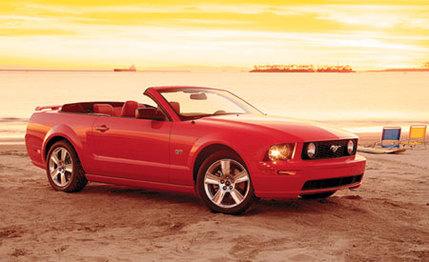
 First Drive Review
First Drive Review
Hot on the heels of a successful model launch, a Car and Driver 10Best award, and victory in a comparison test against a car with a 100-hp advantage, Ford's Mustang now begets a convertible derivative. And it's a good one. But we'll admit to a persistent concern—before journeying to Irwindale Speedway in California to try the new topless pony car—that the decapitation would gravely compromise the latest Mustang's stiff new structure.
O we of little faith. It turns out the development work on Ford's famous icon was undertaken with the same meticulous care that made Ford's steed this year's triple-crown champion. The engineers stiffened the K-shaped brace that ties together the frame rails, engine, and lower control arms, added a V-brace at the rear (to hook the rear section of the rocker panels to the tire tubs), and used thicker-gauge steel for the rockers. These changes improved the new ragtop Mustang's torsional rigidity to a claimed 6500 foot-pounds per degree (the old car managed 3000) and upped its bending resistance by 25 percent. They say the weight penalty for this is about 120 pounds.
The numbers may be academic, but the results are distinctly tangible. This Mustang convertible hangs together remarkably well on rough surfaces, transmitting little vibration or movement through the steering wheel, with insignificant levels of windshield-frame tremor. All of this is evidence of good cowl rigidity and a tightly constrained structure.
Helping enhance the impression of solidity in the convertible is a slightly softened suspension, with front spring rates that are 9 percent more compliant and rears that are 14 percent softer, shocks that have been revalved for their new mission, and anti-roll bars that are reduced in diameter from 0.8 to 0.7 inch.
Increased suppleness in the undercarriage means less force is transmitted to the body shell. That in turn lessens any tendency in the body structure to act as a spring, twisting in the process. The result is one of the tightest convertibles on the road. Since our demo car was a GT, with the 300-hp V-8 and high-performance chassis calibrations, it suggests that the less-powerful V-6 model is likely to ride even more smoothly.
Despite a slightly softer ride (compared with the coupe), our GT convertible took to the tortuous roads in the San Bernardino Mountains with aplomb. The steering response is clear and accurate, providing instinctive path control on the part of the driver. The car's nose swings in strict accordance with your expectations and stays on line with an easy precision. Better yet, the droptop GT handles transitions with agility, flicking from one direction to the other without overshooting your intended arc. And it does this at tire-squealing cornering velocities as well as at moderate speeds.